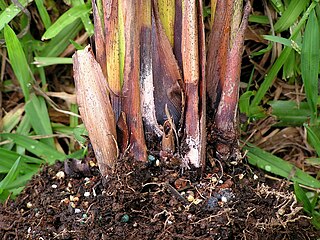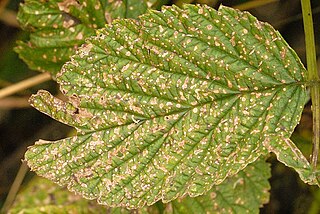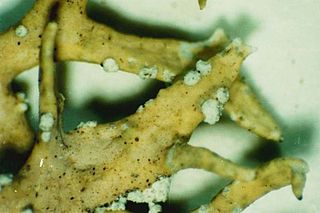
A mycorrhiza is a symbiotic association between a fungus and a plant. The term mycorrhiza refers to the role of the fungus in the plant's rhizosphere, its root system. Mycorrhizae play important roles in plant nutrition, soil biology, and soil chemistry.

A lichen is a composite organism that arises from algae or cyanobacteria living among filaments of multiple fungi species in a mutualistic relationship. Lichens are important actors in nutrient cycling and act as producers which many higher trophic feeders feed on, such as reindeer, gastropods, nematodes, mites, and springtails. Lichens have properties different from those of their component organisms. They come in many colors, sizes, and forms and are sometimes plant-like, but are not plants. They may have tiny, leafless branches (fruticose); flat leaf-like structures (foliose); grow crust-like, adhering tightly to a surface (substrate) like a thick coat of paint (crustose); have a powder-like appearance (leprose); or other growth forms.

An arbuscular mycorrhiza (AM) is a type of mycorrhiza in which the symbiont fungus penetrates the cortical cells of the roots of a vascular plant forming arbuscules. Arbuscular mycorrhiza is a type of endomycorrhiza along with ericoid mycorrhiza and orchid mycorrhiza .They are characterized by the formation of unique tree-like structures, the arbuscules. In addition, globular storage structures called vesicles are often encountered.
The Consortium for the Barcode of Life (CBOL) was an international initiative dedicated to supporting the development of DNA barcoding as a global standard for species identification. CBOL's Secretariat Office is hosted by the National Museum of Natural History, Smithsonian Institution, in Washington, DC. Barcoding was proposed in 2003 by Prof. Paul Hebert of the University of Guelph in Ontario as a way of distinguishing and identifying species with a short standardized gene sequence. Hebert proposed the 658 bases of the Folmer region of the mitochondrial gene cytochrome-C oxidase-1 as the standard barcode region. Hebert is the Director of the Biodiversity Institute of Ontario, the Canadian Centre for DNA Barcoding, and the International Barcode of Life Project (iBOL), all headquartered at the University of Guelph. The Barcode of Life Data Systems (BOLD) is also located at the University of Guelph.

A leaf spot is a limited, discoloured, diseased area of a leaf that is caused by fungal, bacterial or viral plant diseases, or by injuries from nematodes, insects, environmental factors, toxicity or herbicides. These discoloured spots or lesions often have a centre of necrosis. Symptoms can overlap across causal agents, however differing signs and symptoms of certain pathogens can lead to the diagnosis of the type of leaf spot disease. Prolonged wet and humid conditions promote leaf spot disease and most pathogens are spread by wind, splashing rain or irrigation that carry the disease to other leaves.
Olpidium brassicae is a plant pathogen, it is a fungal obligate parasite. In 1983, the Alsike, Alberta area's clover was struck by a fungus epidemic of Olpidium brassicae, previously not seen in Canada.
Ramularia necator is a fungal plant pathogen infecting coconut palms.
Fusicladium pisicola is a species of fungal plant pathogen affecting pea plants.
Pleosphaerulina sojicola is a plant pathogen commonly causing spotted decolouration on the leafs of soybeans.
Elsinoe rosarum, Anthracnose, is a fungal plant pathogen. It is a condition found on roses, causing leaves to have irregular dark margins and spots. The disease usually appears during wet weather.
Sphaceloma menthae is a plant pathogen infecting mint. It is also known as mint anthracnose or leopard spot disease. It can be identified by circular, oval, or irregular spots on the mint plant. It used to be a serious disease but it now controlled in commercial mint fields.
Ascochyta asparagina is a fungal plant pathogen. It causes stem blight of asparagus, causing loss or death of branches.

Gliocladium vermoeseni is a plant pathogen. It is a disease of palm species.

Myriangiales is an order of sac fungi, consisting of mostly plant pathogens.

Soredia are common reproductive structures of lichens. Lichens reproduce asexually by employing simple fragmentation and production of soredia and isidia. Soredia are powdery propagules composed of fungal hyphae wrapped around cyanobacteria or green algae. These can be either scattered diffusely across the surface of the lichen's thallus, or produced in localized structures called soralia. Fungal hyphae make up the basic body structure of lichen. The soredia are released through openings in the upper cortex of the lichen structure. After their release, the soredia disperse to establish the lichen in a new location.

A fungus is any member of the group of eukaryotic organisms that includes microorganisms such as yeasts and molds, as well as the more familiar mushrooms. These organisms are classified as one of the traditional eukaryotic kingdoms, along with Animalia, Plantae and either Protista or Protozoa and Chromista.

In botany, sessility is a characteristic of plant parts that have no stalk. Plant parts can also be described as subsessile, that is, not completely sessile.

Techtochrysin is a chemical compound. It is an O-methylated flavone, a flavonoid isolated from Prunus cerasus, the sour cherry, a plant native to much of Europe and southwest Asia.

An ectomycorrhiza is a form of symbiotic relationship that occurs between a fungal symbiont, or mycobiont, and the roots of various plant species. The mycobiont is often from the phyla Basidiomycota and Ascomycota, and more rarely from the Zygomycota. Ectomycorrhizas form on the roots of around 2% of plant species, usually woody plants, including species from the birch, dipterocarp, myrtle, beech, willow, pine and rose families. Research on ectomycorrhizas is increasingly important in areas such as ecosystem management and restoration, forestry and agriculture.

Botrytis is a genus of anamorphic fungi in the family Sclerotiniaceae. Botrytis belongs to the group hyphomycetes and has about 30 different species. It is a plant parasite as well as saprophytes on both agricultural and forest trees. It produces stout, dark, branching conidiophores that bear clusters of paler conidia on denticles from apical ampullae. It is a common outdoor fungus and can be detected in spore trap samples. The fungus is often found growing on indoor plants. Although no mycotoxin has been reported from this fungus, it may cause hay fever, asthma and keratomycosis. The most common species is B. cinerea, which is a plant pathogen causing gray mould on a very broad range of hosts including some common ornamental plants, such as geranium, begonia, rose, lily, dogwood, rhododendron, dahlia, magnolia, camellia and fruits and produce. This fungus is mainly of outdoor origin, although it may be from growth on fruits or flowers brought in from outdoors. Some houseplants can be infected by this fungus, such as cyclamen, poinsettia, chrysanthemum, and gerbera. Other species of Botrytis may be present, such as B. peoniae on peonies, B. squamosa on onion, and B. tulipae on tulips. These species of Botrytis share some common characteristics in pathology and ecology.











